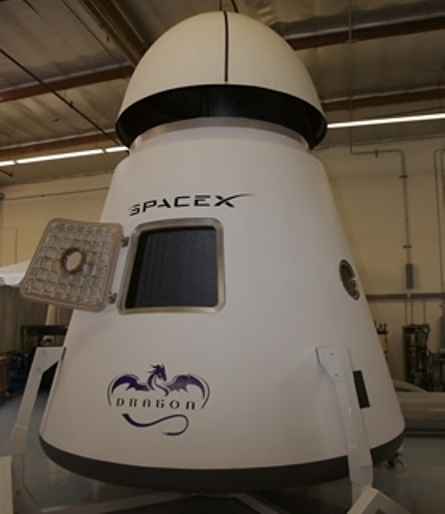Space Exploration Technologies (SpaceX) is preparing for what it admits is the toughest milestone yet for NASA's commercial orbital transportation services programme (COTS), following the granting of its Cape Canaveral Air Force Station Space Launch Complex 40 (SLC-40) operational licence by the US Air Force.
The licence will enable SpaceX to initiate launch operations for its Falcon 9 rocket later this year, starting with a fit check this December of SLC-40 using a Falcon 9 that has undergone engine firing testing in Texas and eventually leading to its COTS demonstation mission one, scheduled for June 2009.
Meanwhile, SpaceX is facing the critical design review for the COTS International Space Station resupply demonstration missions two and three scheduled for November 2009 and March 2010, during which SpaceX's Dragon spacecraft will dock with the ISS.
|
|---|
Above: SpaceX's Dragon spacecraft engineering model at its facility in Hawthorne, California |
SpaceX's COTS space act agreement (SAA) with NASA specifies 22 milestones, including the three demonstration missions, which the company refers to as C1, C2 and C3. The C2/C3 CDR is one of the 10 remaining milestones after SpaceX's successful completion of 12 of them.
The final 10 also includes the missions' readiness reviews, the three flights themselves and a payload processing demonstration. While C1 was originally scheduled for this month it emerged in February that SpaceX was facing a nine-month delay. The new milestone dates followed a renegotiation earlier this year when SpaceX realised that the readiness reviews they were required to do demanded rocket and spacecraft qualification tests many months before the missions took place. However SpaceX only had the capacity to construct the models to be tested about eight weeks before launch.
There were also outstanding issues of UHF communications equipment that had to be installed on the ISS and this will only occur now during NASA's STS-130 Space Shuttle mission scheduled for December 2009.
Vozoff said that media reports of the delay being linked to a welding problem on the Merlin 1C engine were wrong. There was a weld issue but SpaceX says that was resolved at the beginning of the year and does not affect its plans for a 125,000lb-thrust (556kN) at sea-level version of its Falcon 9 "M9" Merlin 1C engine. The Falcon 1 version, the M1, has gas generators that only deliver 78,000lb sea-level thrust because that is what that rocket is designed for.
Instead Vozoff pointed to the renegotiation agreement with NASA that set the company four technical milestones, two of which have been completed. The four are a successful test firing of prototype Dragon Draco thrusters, which occured in March, a Falcon 9 multi-engine test firing, which occured two months earlier than planned, the delivery of the UHF unit and the third demonstration flight. Under its SAA SpaceX's UHF unit can be used by other spacecraft docking with ISS including Orion and Orbital Science's Cygnus.
Vozoff was confident of achieving the remaining third financial milestone, saying that the company was already half way to completing it although it does not have to be achieved until next March.
Other future technical developments include the Dragon capsule's parachute testing. The drogue and main chutes are in their boxes on the company's factory floor and drop tests are planned for the first half of 2009.
Source: Flight International























